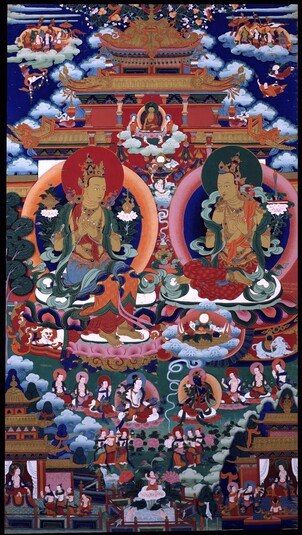
Item: Maitreya (Bodhisattva & Buddhist Deity)
| Origin Location | Tibet |
|---|---|
| Date Range | 1900 - 1959 |
| Lineages | Gelug |
| Material | Ground Mineral Pigment on Cotton |
| Collection | Rubin Museum of Art |
Classification: Deity
Maitreya and Manjushri, Bodhisattva (T. jang chub sem pa. E. Heroic Aspirant to Enlightenment). Maitreya, meaning loving kindness, and Manjushri (Manjughosha), melodious voice, are included among the eight special 'heart-sons' transcendent students of the Buddha Shakyamuni according to Northern Buddhism (Mahayana).
Maitreya, on the left, is recognizable by his seated posture with the legs extended over the front of the throne. He holds two lotus blossoms that support a golden wheel on his right and a water flask on the left. These three characteristics, seated posture, wheel and flask, are unique to the artistic and iconographic appearance specific for Maitreya.
Manjushri holds the stem of a single lotus that supports an upright sword above a folio book. The sword and book are the unique characteristics associated with Manjushri.
In this painting both figures sit together as if in conversation on a green lawn in front of a large ornate palace structure. The well-known bodhisattva white Avalokiteshvara and blue Vajrapani are seated directly below but in much smaller scale, surrounded by other attendant bodhisattvas. In the sky above, gods standing upon billowing clouds hold victory banners and celebratory parasols while figures below soar through the sky with garlands of flowers or large single blossoms.
The setting for the painting is the Tushita Heaven, Joyful Land, the abode of Maitreya, above Mount Sumeru, the center of a Buddhist world system, of which there are many, as he waits for the time when he will descend to earth and be the next Buddha after the time of Buddha Shakyamuni has passed.
An inscription below Maitreya gives the name of the heaven. Another inscription to the right side of Manjushri refers to the occasion of the meeting of Maitreya and Manjushri in this depiction.
Jeff Watt 3-2006
Front of Painting
Wylie Transliteration of Inscription: dga ldan zhing bkod.
Buddhist Deity: Manjushri Main Page
Buddhist Deity: Maitreya Main Page
Collection of Rubin Museum of Art (RMA): Main Page
Buddhist Deity: Manjushri (Non-iconic Forms)
Buddhist Deity: Maitreya (Tushita Heaven)
Buddhist Deity: Maitreya (Seated Posture)
Subject: Manjushri & Maitreya in Dialogue




